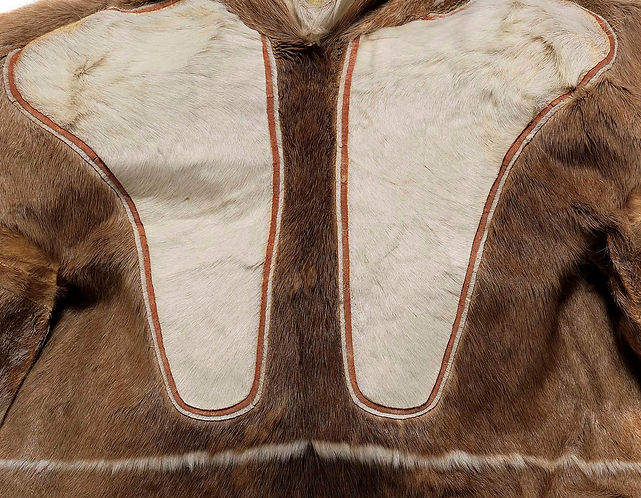
ILIKTIRUTIT AALLANNGUQHIMAYUT
PATTERNS OF CHANGE
MODES DE CHANGEMENT

ILIKTIRUTIT AALLANNGUQHIMAYUT
PATTERNS OF CHANGE
MODES DE CHANGEMENT
NAUPKAQTANGIT ILIKTIRUTINGIT AALLANNGUQPALLIANINGIT
CREATING PATTERNS OF CHANGE
CRÉATION DE 'PATTERNS OF CHANGE'

Annie Atighioyak and Mabel Etegik with the completed Inuinnait Parka exhibit at the May Hakongak Centre.
The winter parka has long been a staple of survival for Inuinnait, and is deeply intertwined with our identity, culture and history. In 2017, we initiated Patterns of Change to research the stylistic and material evolution of the Inuinnait parka over the last 150 years. In addition to revitalizing important Inuinnaqtun language, skills and technologies involved in the making of historical parkas, the project served as a way to reflect on the various social changes that have impacted Inuinnait since contact with the western world.
The Patterns of Change sewing program was managed by our team of Elders-in-Residence, Mary Avalak, Mabel Etegik and Annie Atighioyak. From 2017 to 2019, these women oversaw the teaching of multiple community workshops designed to five Inuinnait parkas representing 30 year increments in the historical trajectory of Inuinnait. The creation of each parka was heavily researched, and meticulously sewn according to the materials, processes, and styles of the particular historical era they represent. For the earliest parka (1880), materials were harvested from the land and sewing tools made from the hammering of locally sourced copper. For a later parkas (1930 and 1950), historically accurate wool stockings, sewing machines and military issued winter supplies were located based on careful observation of historical photos and research into the era's Hudson Bay catalogues.
Despite the sewing workshops' focus on historical accuracy, the purpose of this project was ultimately to transfer knowledge surrounding Inuinnait parkas into the future. Patterns of Change worked extensively with language experts to document fine grained Inuinnaqtun terminology surrounding Inuinnait clothing and sewing techniques. Sewing workshops encouraged participants to learn from Elders, but also to apply this knowledge towards the creation of parkas for their family and friends. The final Patterns of Change exhibit is accompanied by an interactive community
sewing pattern library that encourages public tracing, borrowing, and exchange of sewing patterns.

Pamela Gross visits a collection of historical Inuinnait parkas at the Canadian Museum of History.

Bessie Omilgoetok holds up a 100 year old Inuinnait parka collected by the Fifth Thule Expedition, during a research trip to the Danish National Museum.
The Inuinnaqtun translation course at Nunavut Arctic College works with Elders in Cambridge Bay to document the terminology surrounding parka manufacture.


